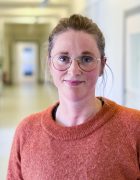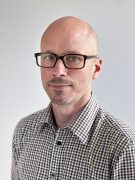EDUCATION. The Speech and Language Pathology Program at Sahlgrenska Academy is the last to satisfactorily implement its quality assurance procedures in keeping with the University of Gothenburg’s quality assurance policy. Quality assurance efforts at the programs will now move on to the next step. The faculty’s six-year quality cycle restarts after the summer.
Emilia Carlsson has been responsible for the Speech and Language Pathology program for about a year now. The program has just presented its action plan to the Council for Education, which was based on a report by the external assessment panel, and this plan has been adopted. Emilia Carlsson notes that the program received good ratings in the assessment panel’s report:

“This has been very positive for us since the assessment panel judges that we successfully satisfy all the criteria. We are very happy about this excellent assessment. At the same time, the panel had a lot of reflections and comments, and we have received several good suggestions for measures that we also choose to include in our action plan,” says Carlsson.
A few years ago, the Speech and Language Pathology program completely reworked its program syllabus, and the first cohort of students trained under this syllabus graduated last year. The Speech and Language Pathology program at Sahlgrenska Academy is judged as high quality based on the assessment criteria. The department’s teaching staff is highly skilled in the subject and in teaching, is well coordinated, and carries out ambitious educational development work. The assessment panel also highlights how the department focuses on student learning, such as by using new professional development modules.
Reflections and recommendations
The teaching team at the Speech and Language Pathology program worked diligently to compile material for the external assessment panel. The panel consisted of a professor of speech therapy from Åbo Akademi University, an associate professor from Karolinska Institutet, a professor of psychology at the University of Gothenburg, a head of office in speech therapy in Region Västra Götaland, and speech therapy students from both Sahlgrenska’s own program and the Speech and Language Pathology program in Linköping. In addition to the compiled background material, the assessment panel also based its report on interviews conducted during site visits at Medicinareberget.
The program will work with a proposal from the assessment panel to clarify the structure for its collaboration with partners to ensure access to clinical placements. The panel also suggested that students be provided more support in improving their writing skills, something that probably applies to virtually all higher education. The program is now planning a one-day workshop where teachers will discuss the progression of writing assignments throughout the education. Regarding student influence in the planning and implementation of education, the assessment panel noted that new student representatives may need a clearer introduction to their formal assignment.
Continual quality assurance
The current quality assurance system for higher education in Sweden has been in place since 2016. At that time, the Swedish Higher Education Authority (UKÄ) delegated most of the responsibility for quality audits of individual courses to the higher education institutions. Now, the Swedish Higher Education Authority assesses quality assurance procedures at the university level. At the University of Gothenburg, quality assurance includes three processes: a locally designed process where Sahlgrenska Academy has chosen to focus on qualitative target matrices and annually updated and compiled program reports; program evaluations with an external assessment panel conducted in six-year cycles; and finally, university-wide follow-up where the Vice-Chancellor reviews the faculties’ quality assurance procedures through operational and educational discussions.

Jonas Gren, development manager at the Sahlgrenska Academy Office, is the faculty’s member on the University Board of Education’s quality assurance committee. Together with vice deans Gunnar Tobin and Gudmundur Johansson, the teacher responsible for quality assurance at the faculty, he is working on proposals to the Council for Education on how the University’s quality assurance process can be interpreted at faculty level so that it can work in the context of Sahlgrenska Academy.
“The programs generally seem to be quite satisfied with the way the process works,” says Jonas Gren. “It is my impression that this work contributes greatly to the day-to-day improvement of the programs. Compared with the Swedish Higher Education Authority’s previous quality assurance reviews, the focus is more on quality improvement and constructive suggestions and less on the more controlling aspects of quality assurance procedures.”
The first program will start the next cycle of the external six-year review this autumn.
BY: ELIN LINDSTRÖM











